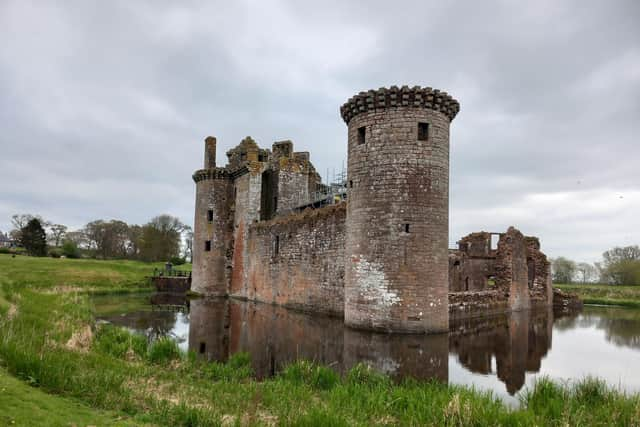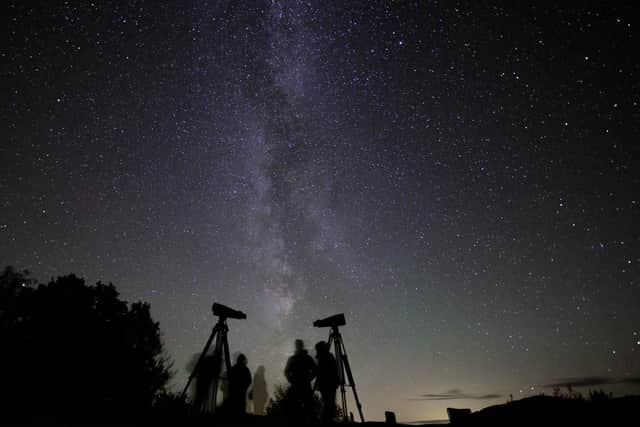How the Cairndale Hotel in Dumfries is providing guests with the greatest show in the universe
Tourists who dream of experiencing an umblemished view of the heavens from the ruins of a famous castle can head to Scotland this autumn and winter, as one of Dumfries’ largest hotels – The Cairndale Hotel and Leisure Club - attracts a new generation of visitors.
Cairndale director Matthew Wallace promises an experience for guests which is “literally out of this world”.
Advertisement
Hide AdAdvertisement
Hide Ad“Dumfries and Galloway is famous worldwide for its dark skies so this is the perfect way to enjoy great Scottish hospitality and marvel at the beauties of the universe,’’ he said.


Standing near a ruined castle on a cloudless night offers the perfect opportunity for visitors to gain a fresh perspective on their place in the universe.
The Dark Sky Rangers in Galloway have joined forces with the Cairndale to host a two night package of star gazing in the grounds of Caerlaverock Castle, which stands close to the sea, seven miles from Dumfries. The initial event – held on Valentine’s Day this year- proved so successful that the hotel has announced it will run two more dark skies packages on 28 and 29 September and 8 and 9 November.
At Caerlaverock, a maximum of 18 people will view constellations through astrobinoculars, learn how to navigate and tell the time by the stars, and hear stories, myths and legends. Back at the hotel they will enjoy dinner “under the heavens” in a heated glass fibre dome in the garden. It’s part of a package of measures implemented by the family-run Cairndale as the tourism sector recovers from a “challenging” period overshadowed by Covid. Mr Wallace said that the hotel, and the region around it, has bounced back to life after the “blip” that was 2020 to 2022. With its lavishly refurbished reception area, impressive restaurant, leisure club, swimming pool and live entertainment calendar, which includes a scheduled performance by the legendary singer Kiki Dee later this year, the Cairndale certainly has a spring in its step.
Advertisement
Hide AdAdvertisement
Hide AdThe rolling landscape around Dumfries could claim to be one of the most underrated tourist destinations in Britain. Caerlaverock Castle, for example, with its battered walls, drawbridge and moat, is a medieval fortress straight out of central casting. The survival of so much of the castle into the 21st century is a minor miracle, although the interior is currently closed so safety checks can be carried out.


Not all visitors have been welcome. In the early 14th century, the English King Edward I – who had the tell-tale nickname of Hammer of the Scots – would hardly have rated as the perfect house guest. Caerlaverock’s defenders were reluctant to roll out the carpet when they discovered Edward and his army outside their gates on a summer’s day in 1300. The tiny garrison held out for two days despite facing the full might of the English king’s army.
A detailed contemporary report about the siege provides us with a blow by blow account of the defenders’ dogged resistance. Today, it’s a haunting semi-ruin where the silence is only broken by the sounds of children playing or the cry of birds from the nearby national nature reserve. Just down the hill from the Cairndale in the heart of Dumfries, you encounter a trail dedicated to Robert Burns, Scotland’s national poet, who lived in the town in the 1790s. You can still see the Theatre Royal which was regularly visited by Burns and the Globe Close Inn, where he held court once his day job as an exciseman was done. Robert Burns house, where the poet and his family lived from 1793 until his premature death, aged just 37, in 1796, is a simple sandstone building that has become a place of pilgrimage for Burns' fans from around the world.
The blood-red sandstone of the ruined Sweetheart Abbey, which stands south of Dumfries, is a memorial to a love affair for the ages. It was founded in the 1270s by Lady Dervorguilla of Galloway, the grieving widow of Lord John Balliol. She is said to have carried her husband’s embalmed heart, which was placed in an ivory casket, with her everywhere. When she too died in 1289, Dervorguilla was buried in front of the abbey church’s high altar, clutching her husband’s heart to her bosom. Although access is limited as safety inspections are carried out, the ruin has a mournful grandeur, which is perhaps most apparent from a distance.
Advertisement
Hide AdAdvertisement
Hide AdThis is a region which has faced outwards and shaped world events. Proof of this can be found in a tiny white cottage in the village of Kirkbean, which was the birthplace John Paul Jones, the father of the United States Navy. A Scottish gardener’s son, Jones became a distinguished naval officer fighting for both the US and Russia; although in Britain he was remembered as a pirate who once raided Whitehaven and fought a battle with the Royal Navy off Flamborough Head. The cottage and museum dedicated to John Paul Jones provides an insight into his humble beginnings and includes a reconstruction of the captain’s cabin from his most famous ship, the Bonhomme Richard. Like Burns, John Paul Jones died young, but left an indelible impression on world history. Dumfries has always been a place for dreamers with their eyes on the stars.


Greg Wright stayed for two nights at the Cairndale Hotel and Leisure Club in English Street, Dumfries, Scotland. For more information on the Dark Skies package email [email protected] or visit www.cairndalehotel.co.uk